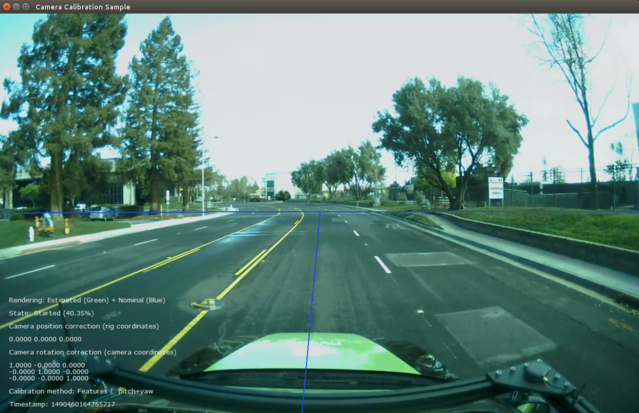Camera Calibration Sample
Table of Contents
Description
This sample demonstrates the estimation of camera extrinsic calibration parameters using the NVIDIA® DriveWorks Calibration Engine.
Running the Sample
The camera calibration sample, sample_calibration_camera, accepts the following optional parameters. If none are specified, the camera extrinsics are estimated on a default dataset.
./sample_calibration_camera --rig=[path/to/rig/configuration/file]
--camera-sensor=[integer/sensor-name]
--imu-sensor=[integer/sensor-name]
--can-sensor=[integer/sensor-name]
--signals='default', or any combination of ['pitchyaw','roll','height'] substrings
--feature-max-count=[integer]
where
--rig=[path/to/rig/configuration/file]
Path to the rig configuration file.
Default value: path/to/data/samples/recordings/suburb0/rig.json
--camera-sensor=[integer]
The index or name of the camera sensor in the rig configuration file to calibrate
Default value: 0
--imu-sensor=[integer]
The index or name of the IMU sensor in the rig configuration file
Default value: 0
--can-sensor=[integer]
The index or name of the CAN sensor in the rig configuration file
Default value: 0
--signals='default', or any combination of ['pitchyaw','roll','height'] substrings
The camera extrinsic parameters to estimate, given as any combination of
['pitchyaw','roll','height'] substrings, or 'default'.
For instance, the combination `pitchyawroll` will enable estimation of all
orientation components (roll+pitch+yaw), if supported by the chosen method.
'default' enables signals that are well-supported by the calibrated sensor.
For instance, the calibration of less signals might be activated by default
for side-facing cameras compared to front-facing cameras.
Default value: default
--fast-acceptance: ['default', 'enabled', 'disabled']
If previously accepted estimates are available, fast-acceptance is a method
to reduce re-calibration times in case the previous estimates can be
validated with latest measurements. This option allows to configure the
fast-acceptance behaviour of the camera calibration routine.
Default value: 'disabled' (to illustrate calibration from scratch)
--feature-max-count=[integer]
The maximum number of features for the tracker.
Default value: 800
Output
The sample does the following:
- Creates a window.
- Displays a video.
- Displays nominal calibration indicators (blue) and, after convergence, corrected calibration indicators (green).
Indicators show the estimated rig horizon and forward directions, as seen from the camera's pose relative to the rig. The resulting display shows a visualization of the nominal and estimated extrinsic calibration parameters.

Camera Calibration
Additional information
For more details on camera calibration see Feature-based Camera Self-Calibration .